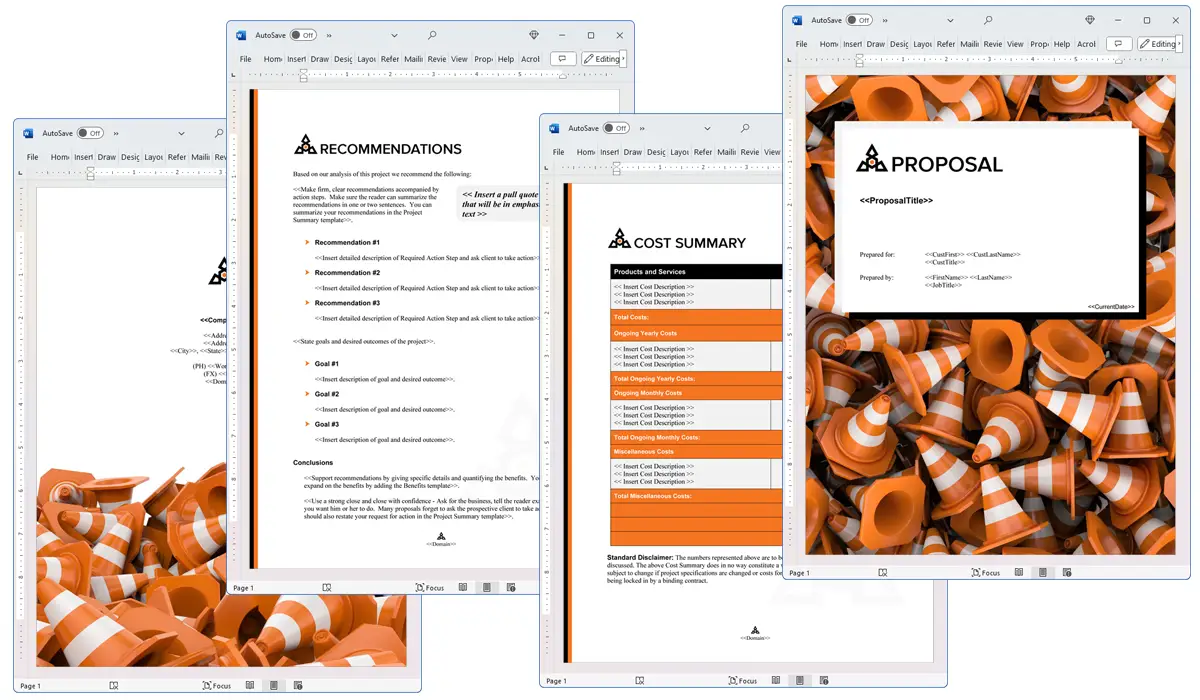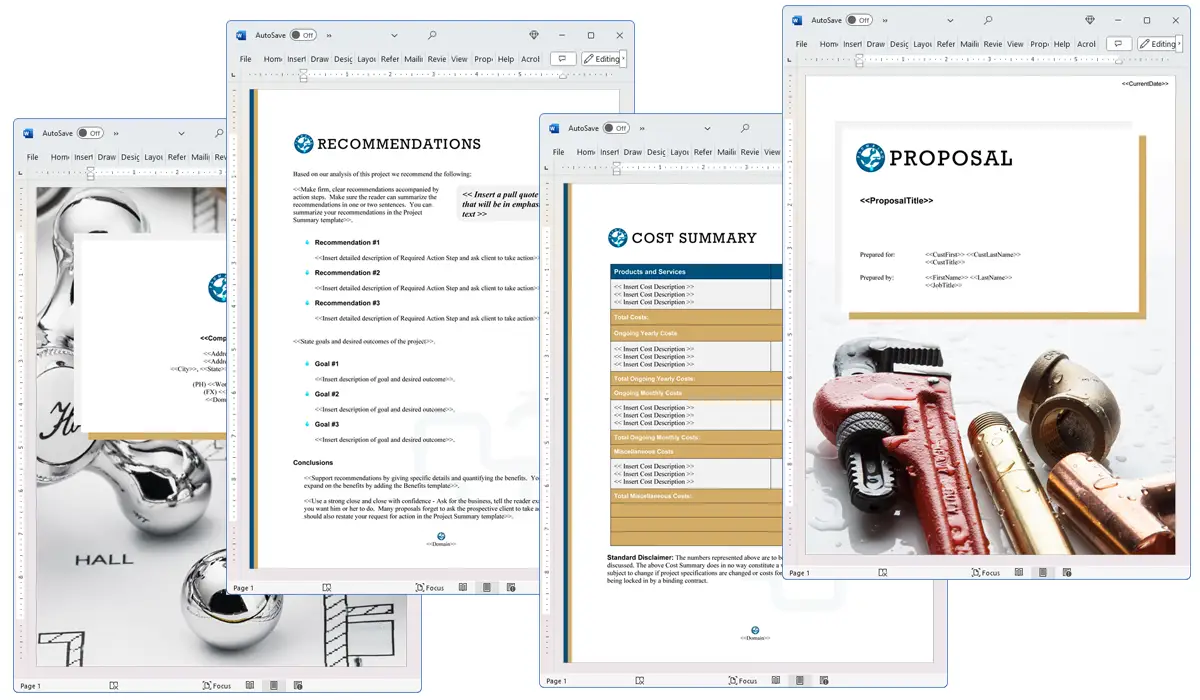What is the Self-Sufficiency chapter used for?
Proposal Kit Professional Bundle adds more design themes, all six Contract Packs,
a project management library, and Expert Edition software.

Illustration of Proposal Pack Safety #5
We include this Self-Sufficiency chapter template in every Proposal Pack, along with thousands more. You assemble this chapter with others in various combinations to create custom-tailored business proposals, plans, reports, and other documents. Proposal Packs apply custom visual designs to the templates, giving the final documents a consistent professional finish.
 DOWNLOADABLE, ONE-TIME COST, NO SUBSCRIPTION FEES
DOWNLOADABLE, ONE-TIME COST, NO SUBSCRIPTION FEES
Overview of the Self-Sufficiency Chapter
In the field of business proposals, the Self-Sufficiency chapter plays an important role in illustrating how a business can operate independently and sustainably. This chapter is crafted to help businesses outline strategies that will enable them to reduce reliance on external resources, whether these resources are financial, material, or human. By incorporating the Self-Sufficiency chapter, businesses can present a case to stakeholders on the viability and long-term stability of their operations.
How is the Self-Sufficiency Chapter Used?
The Self-Sufficiency chapter is primarily used in business proposals to address potential and existing concerns about a business's ability to sustain itself without external aid. This chapter provides a overview of the methods and plans a business will implement to achieve self-sufficiency. It serves as a reassurance to investors, partners, and other stakeholders that the business has a robust roadmap towards independence and sustainability, which is crucial for long-term success.
What is Included in the Self-Sufficiency Chapter?
Typically, the Self-Sufficiency chapter includes several key elements:
- Current State Analysis: An assessment of the current level of dependence on external resources.
- Goals for Self-Sufficiency: Specific, measurable objectives that the business aims to achieve to become self-sufficient.
- Strategies and Actions: Detailed plans on how the goals will be accomplished, including timelines and responsible parties.
- Expected Challenges and Solutions: An overview of potential obstacles in the path to self-sufficiency and preemptive solutions or mitigations.
- Benefits of Self-Sufficiency: An explanation of how achieving self-sufficiency will benefit the business, including financial stability, improved control over operations, and enhanced market reputation.
Use Case Examples for the Self-Sufficiency Chapter
The Self-Sufficiency chapter can be adapted across various industries and services within a proposal. Here are some specific examples:
- Personal Care Services: Proposing how a personal care facility can operate independently by training staff internally and using locally sourced supplies.
- Employment: Outlining strategies for a staffing agency to rely less on external job boards by cultivating a proprietary database of candidates.
- Human Resources: Demonstrating how a company can develop an in-house HR training program to minimize the need for external consultants.
- Social Services: Explaining how a nonprofit can achieve financial independence through community-based fundraising and partnerships.
- Community and Faith Organizations: Describing methods for community centers or religious groups to self-fund through member donations and volunteer-driven events.
- Training and Education: Proposing how an educational institution can become self-sufficient by offering online courses and certifications that generate additional revenue.
Key Takeaways
- Strategic Importance: The Self-Sufficiency chapter helps businesses articulate their strategy for becoming independent and sustainable.
- Stakeholder Assurance: It reassures investors and partners of the business's long-term viability and stability.
- Versatility: This chapter is adaptable across various industries and types of proposals.
- Comprehensive Content: Includes analysis, objectives, strategies, challenges, and benefits related to achieving self-sufficiency.
- Improved Business Model: Promotes a business model that prioritizes internal growth and resource management.

Illustration of Proposal Pack Travel #5
 What Our Clients Say
What Our Clients SayThe Proposal Kit benefits every client we have. It has great material on every level and is very affordable for small to medium businesses."
COO at Janus Consulting
 4.7 stars, based on 845 reviews
4.7 stars, based on 845 reviewsRelated Chapters
Document Layouts Using the Self-Sufficiency Chapter

The Self-Sufficiency chapter and other chapters are integrated into a Word document as illustrated here in the Proposal Pack Plumbing #2 design theme. There are hundreds of design themes available, and every design theme includes the Self-Sufficiency chapter template.
A proper business proposal will include multiple chapters. This chapter is just one of many you can build into your proposal. We include the complete fill-in-the-blank template in our Proposal Pack template collections. We also include a library of sample proposals illustrating how companies in different industries, both large and small, have written proposals using our Proposal Packs. This template will show you how to write the Self-Sufficiency.
We include a chapter library for you to build from based on your needs. All proposals are different and have different needs and goals. Pick the chapters from our collection and organize them as needed for your proposal.
Using the Proposal Pack template library, you can create any business proposal, report, study, plan, or document.
 Ian Lauder has been helping businesses write their proposals and contracts for two decades. Ian is the owner and founder of Proposal Kit, one of the original sources of business proposal and contract software products started in 1997.
Ian Lauder has been helping businesses write their proposals and contracts for two decades. Ian is the owner and founder of Proposal Kit, one of the original sources of business proposal and contract software products started in 1997.By Ian Lauder
 Published by Proposal Kit, Inc.
Published by Proposal Kit, Inc.


 Cart
Cart
 Facebook
Facebook YouTube
YouTube X
X Search Site
Search Site